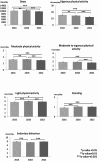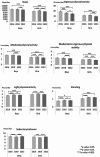Physical activity has decreased in Finnish children and adolescents from 2016 to 2022
- PMID: 38762462
- PMCID: PMC11102264
- DOI: 10.1186/s12889-024-18854-7
Physical activity has decreased in Finnish children and adolescents from 2016 to 2022
Abstract
Background: Varying trends in children's and adolescents' physical activity (PA) have been reported during the last 10-20 years. Trends in sedentary behavior (SB) have been studied only rarely. The purpose of the present study was to describe population-based trends in accelerometer-measured PA, standing and SB, among Finnish 7-15-year-old children and adolescents, and to evaluate the potential influence of the COVID-19 pandemic on these behaviors.
Method: A cross-sectional population-based Finnish school-aged physical activity Study (FSPA) measured daily steps, vigorous (VPA), moderate (MPA), moderate-to-vigorous (MVPA), light physical activity (LPA), standing, and SB by an accelerometer for seven consecutive days in 2016, 2018, and 2022 (n = 7.080, 57% girls). The data was analyzed by multivariate regression analysis.
Results: In 2016, participants took on average 10.305 steps per day, and spent 0:15 (h: min) in VPA, 1:37 in MPA, 1:52 in MVPA, 3:48 in LPA, 0:55 in standing and 7:52 in SB. From 2016 to 2018, daily steps, MPA, LPA, and standing increased [229 steps (95% Confidence Interval, CI 70-387), 0:03 (CI 0:01 - 0:04), 0:11 (CI 0:09 - 0:14), and 0:07 (CI 0:05 - 0:08), respectively], while VPA and SB decreased [0:01 (CI 0:00-0:02) and 0:20 (CI 0:16 - 0:24), respectively]. From 2018 to 2022, daily PA and standing declined [751 steps (CI 562-939), VPA 0:02 (CI 0:01 - 0:03), MPA 0:09 (CI 0:07 - 0:11), MVPA 0:11 (CI 0:09 - 0:14), LPA 0:08 (CI 0:05 - 0:11), and standing 0:01 (CI 0:01 - 0:03)] while SB increased 0:21 (CI 0:16 - 0:25) indicating potential influence of the pandemic.
Conclusions: Children and adolescents became physically less active from 2016 to 2022. The potential effects of the COVID-19 were seen as declined PA and increased sedentariness from 2018 to 2022.
Keywords: Accelerometry; Physical activity; Sedentary behavior.
© 2024. The Author(s).
Conflict of interest statement
The authors declare no competing interests.
Figures




Similar articles
-
Objectively measured sedentary behavior and physical activity of Finnish 7- to 14-year-old children- associations with perceived health status: a cross-sectional study.BMC Public Health. 2016 Apr 16;16:338. doi: 10.1186/s12889-016-3006-0. BMC Public Health. 2016. PMID: 27083559 Free PMC article.
-
Associations of emotional/behavioral problems with accelerometer-measured sedentary behavior, physical activity and step counts in children with autism spectrum disorder.Front Public Health. 2022 Oct 10;10:981128. doi: 10.3389/fpubh.2022.981128. eCollection 2022. Front Public Health. 2022. PMID: 36299767 Free PMC article.
-
Associations Between Parent Self-Reported and Accelerometer-Measured Physical Activity and Sedentary Time in Children: Ecological Momentary Assessment Study.JMIR Mhealth Uhealth. 2020 May 19;8(5):e15458. doi: 10.2196/15458. JMIR Mhealth Uhealth. 2020. PMID: 32348283 Free PMC article.
-
Sedentary behaviors and physical activity of the working population measured by accelerometry: a systematic review and meta-analysis.BMC Public Health. 2024 Aug 6;24(1):2123. doi: 10.1186/s12889-024-19449-y. BMC Public Health. 2024. PMID: 39107699 Free PMC article.
-
Accelerometer-measured physical activity and sedentary behavior in Chinese children and adolescents: a systematic review and meta-analysis.Public Health. 2020 Sep;186:71-77. doi: 10.1016/j.puhe.2020.07.001. Epub 2020 Aug 9. Public Health. 2020. PMID: 32784098
Cited by
-
Retrograde Flow to Aortic Root Predicts Inferior Cardiopulmonary Performance and Restrictive Lung Physiology in Fontan Circulation.CJC Pediatr Congenit Heart Dis. 2024 Aug 23;3(6):265-271. doi: 10.1016/j.cjcpc.2024.08.002. eCollection 2024 Dec. CJC Pediatr Congenit Heart Dis. 2024. PMID: 39959631 Free PMC article.
-
Effectiveness of the Let's Move It multi-level vocational school-based intervention on physical activity and sedentary behavior: a cluster randomized trial.Ann Behav Med. 2025 Jan 4;59(1):kaaf023. doi: 10.1093/abm/kaaf023. Ann Behav Med. 2025. PMID: 40423552 Free PMC article. Clinical Trial.
-
Association of impaired pulmonary function and objectively measured physical activity in a population study.Sci Rep. 2025 Jul 24;15(1):27004. doi: 10.1038/s41598-025-12517-2. Sci Rep. 2025. PMID: 40707715 Free PMC article.
References
-
- Carson V, Hunter S, Kuzik N, Gray CE, Poitras VJ, Chaput JP, Saunders TJ, Katzmarzyk PT, Okely AD, Connor Gorber S, et al. Systematic review of sedentary behaviour and health indicators in school-aged children and youth: an update. Appl Physiol Nutr Metab. 2016;41(6 Suppl 3):S240–265. doi: 10.1139/apnm-2015-0630. - DOI - PubMed
-
- Wu XY, Han LH, Zhang JH, Luo S, Hu JW, Sun K. The influence of physical activity, sedentary behavior on health-related quality of life among the general population of children and adolescents: a systematic review. PLoS ONE. 2017;12(11):e0187668. doi: 10.1371/journal.pone.0187668. - DOI - PMC - PubMed
-
- Poitras VJ, Gray CE, Borghese MM, Carson V, Chaput JP, Janssen I, Katzmarzyk PT, Pate RR, Connor Gorber S, Kho ME, et al. Systematic review of the relationships between objectively measured physical activity and health indicators in school-aged children and youth. Appl Physiol Nutr Metab. 2016;41(6 Suppl 3):S197–239. doi: 10.1139/apnm-2015-0663. - DOI - PubMed
Publication types
MeSH terms
Grants and funding
- 320400,320403 and 346607/the Strategic Research Council at the Academy of Finland
- 320400,320403 and 346607/the Strategic Research Council at the Academy of Finland
- 320400,320403 and 346607/the Strategic Research Council at the Academy of Finland
- 320400,320403 and 346607/the Strategic Research Council at the Academy of Finland
- 320400,320403 and 346607/the Strategic Research Council at the Academy of Finland
LinkOut - more resources
Full Text Sources
Medical
Miscellaneous

